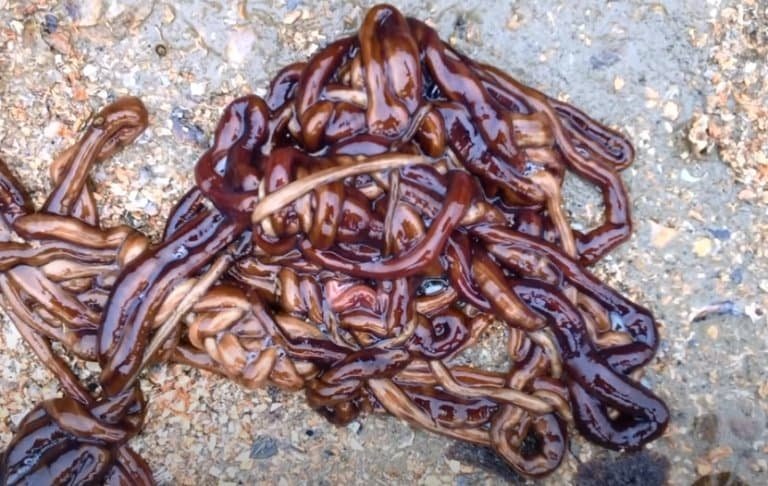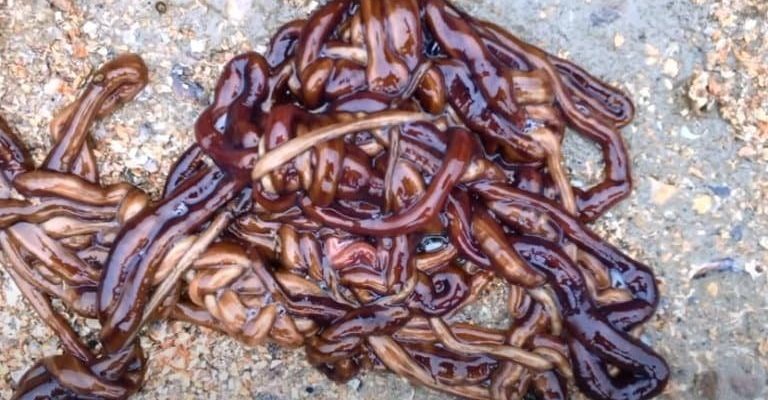
Imagine you’re in a sticky situation, quite literally. Picture a creature that can produce thick strands of mucus to ensnare its prey or ward off predators. That’s what bootlace worms do. They’re not just floating around; they’re experts in hunting and defending themselves. So, let’s dive into the fascinating world of bootlace worm mucus, its uses, and why it matters in the grand scheme of nature.
What Are Bootlace Worms?
Bootlace worms, known scientifically as *Lineus longissimus*, are some of the longest worms in the world. They can stretch up to 55 meters (about 180 feet)! These marine creatures are often found in coastal waters, especially in Europe. Despite their length, they’re pretty harmless to humans.
You might be wondering why they’re called “bootlace” worms. The name comes from their long, thin, and flexible bodies that resemble shoelaces. Living mostly in the sand or mud, they thrive in darker environments, making them less visible to predators and prey. But when it comes to their hunting and defense techniques, that’s where the magic of their mucus comes into play.
The Role of Mucus in Hunting
Mucus is more than just a slimy substance; it’s a vital tool for bootlace worms when hunting. Imagine wandering through a dense jungle; you’d want to have something to navigate the tricky paths, right? For the bootlace worm, mucus serves that purpose in the ocean.
When hunting, they secrete a large amount of mucus into the water. This mucus can ensnare tiny prey like shrimp or plankton, which get stuck in the gooey strands. The worm then slowly moves toward its catch, taking advantage of the sticky trap it has created. In this way, mucus acts almost like a fishing net, capturing unsuspecting meals.
Here’s a fun fact: the mucus isn’t just something you might see floating around. It’s strong and resilient enough to hold onto prey, ensuring that the worm can enjoy a nice meal without having to chase after it. The effectiveness of this technique raises an interesting thought: how many creatures in the ocean utilize such unique methods for survival?
Mucus as a Defense Mechanism
While hunting is one important use of mucus, it’s also a critical defense mechanism. Think about it: in the wild, every creature needs a way to protect itself from predators. Bootlace worms have found a clever way to do just that.
When threatened, these worms can release a copious amount of mucus, creating a slippery barrier between themselves and their attacker. This isn’t just your average slime; it’s a potent deterrent! Predators find it difficult to get a grip on the worm, allowing it time to escape.
This defensive tactic can be particularly effective against fish and other sea creatures that might consider the bootlace worm a snack. It’s almost like having a built-in safety net. So, if you’re ever feeling overwhelmed in a situation, you might wish you had a bootlace worm’s level of self-defense!
The Composition of Bootlace Worm Mucus
You might be curious about what exactly makes bootlace worm mucus so special. The mucus contains a high concentration of **glycoproteins**, which are proteins that have sugar molecules attached to them. This combination makes the mucus both sticky and elastic, perfect for trapping prey and slipping away from danger.
The unique composition is what allows the mucus to vary its consistency. Sometimes, it can be thin and runny, while at other times, it can thicken up to create a more robust barrier. The adaptability of this mucus plays a crucial role in its functionality for both hunting and defense.
Plus, it’s interesting to note that the mucus has certain antibacterial properties. This means that, while it’s helping the worm survive, it’s also keeping any potential infections at bay. It’s like nature’s own first-aid kit, packaged conveniently within the bootlace worm itself!
Potential Applications in Science and Medicine
Believe it or not, the mucus of bootlace worms has captured the interest of scientists and researchers. The properties of their mucus could inspire new materials or methods in various fields. Think of it: scientists are often inspired by nature, finding solutions in the quirkiest places.
For instance, the sticky nature of bootlace worm mucus can be compared to certain medical adhesives used in surgeries. If researchers can replicate the effectiveness of this natural glue, it could lead to better surgical procedures with less risk of infection. Additionally, the antibacterial properties of the mucus could open new doors in medicine, potentially leading to treatments that can combat harmful bacteria.
This connection between marine biology and human innovation shows how interconnected our world is. So, not only do bootlace worms have their own survival strategies, but their unique attributes might help us in ways we can’t yet fully imagine.
Conservation and the Importance of Bootlace Worms
As fascinating as bootlace worms are, they are also part of a larger ecosystem that needs protecting. The health of our oceans directly affects every creature within them, including these remarkable worms. Pollution, climate change, and habitat destruction impact their populations, which can, in turn, affect the entire marine food web.
By conserving marine habitats and promoting sustainable practices, we can help ensure that bootlace worms can continue their unique life cycles. Every little action counts—whether it’s reducing plastic waste, supporting local conservation efforts, or simply spreading the word about these amazing creatures.
Honestly, it’s a reminder that every tiny creature plays a role in the health of our planet. Bootlace worms, with their incredible mucus, are just one small yet vital piece of the ocean puzzle.
So, what have we learned about the mucus of bootlace worms? These intriguing creatures use their slimy secret weapon for both hunting and defense, showcasing the beautifully complex relationships that exist in nature. From ensnaring prey to evading predators, bootlace worm mucus serves as a testament to innovation in the natural world.
As we explore these oceanic wonders, we should remember their importance and the need to protect their habitats. After all, each unique attribute these organisms possess could hold valuable lessons for us and our future. So, the next time you think about the ocean, remember the bootlace worm and its sticky, surprising ways of surviving amidst the waves.

